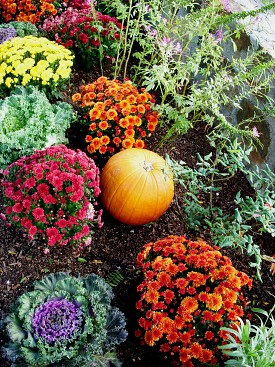The Best Annual Flowers for Fall
 Fall is one of my favorite times in the garden. The heat of summer may have dried out your lawn and many of the flowering plants that burst into bloom in late spring, but fall brings its own beautiful days and a colorful flush of bright annuals and perennials, if you've planned ahead. Lots of gorgeous plants bloom in the fall and can turn the yard into a sea of bright red, yellow, and orange, lifting the gloom of earlier sunsets. And the weather is often fair, a great time for working out in the garden; not too hot, and not yet so cold and wet that everything is a slog.
Fall is one of my favorite times in the garden. The heat of summer may have dried out your lawn and many of the flowering plants that burst into bloom in late spring, but fall brings its own beautiful days and a colorful flush of bright annuals and perennials, if you've planned ahead. Lots of gorgeous plants bloom in the fall and can turn the yard into a sea of bright red, yellow, and orange, lifting the gloom of earlier sunsets. And the weather is often fair, a great time for working out in the garden; not too hot, and not yet so cold and wet that everything is a slog.
Start fall annuals in time to get them well-established so they can get to blooming when autumn comes. Many helpfully self-seed themselves, so once you get them going in the first year, they'll return year after year, as long as they like where they're planted. You can also buy starts at nurseries, of course, and skip the work of sprouting and early care.
If you have a greenhouse, consider using it for starts, so you can get them going early in the late summer months without exposing them directly to the heat and dryness of the outdoors. Starts can also do well in the kitchen or bathroom, where the warm, moist air will keep the seedlings happy as they mature. You can use flats or six-packs for starting—make sure to fill them with good quality potting soil and keep your starts moist and fertilized to support them as they grow.
Chrysanthemums
One of the most famous fall flowers is the chrysanthemum, which tends to get a bit of a bum rap for being boring and brash. In fact, these amazing flowers come in a wide range not just of colors, but also of petal configurations, from delicate long-petaled blooms to tight clusters of flowers with colorful centers. Better yet, they're extremely hardy, and tend to thrive in conditions where other flowers might struggle. Try lining walkways and paths with chrysanthemums, or plant them in flower boxes to add some definitive color to the garden and the home.
Gazanias
Gazanias and their larger cousins, the sunflowers, are also fall bloomers. They make fantastic cut flowers, like chrysanthemums, and they come in an array of colors that look stellar in the garden. They'll need to be planted further back in your beds to compensate for the fact that they're taller, and they look best in clusters to highlight their glorious foliage and beautiful blooms. Some of your sunflowers may need to be staked to encourage them to stay upright, as they can get top-heavy.
More Tall Autumn Blooms
Other taller blooms that can add height and texture to the garden include amaranth (which makes a fantastic dried flower, too), snapdragons, flowering tobacco, marigolds, Salvias like Texas sage, cosmos, twinspur, asters, hollyhocks, and painted tongue. Many of these blooms come in multiple colors, allowing you to coordinate your garden in the shades you want, whether they be a traditional fall melange of orange, red, and yellow tones, or a more radical garden in blues, purples, and rich pinks.
Fall Groundcovers
Want some fall groundcovers to sprawl out and look great into the winter? Fortunately, a lot of beautiful flowering plants adore the fall weather and they'll happily settle in flower beds as well as boxes and containers. These include lobelia, alyssum, trailing petunias, violets, periwinkles, evening primroses, creeping zinnia, nasturtiums, and morning glories. For a garden in stunning fall colors, pick nasturtiums, evening primroses, and alyssum, which come in a range of yellows, reds, and oranges and white, respectively.
Edible Ornamentals
For fall color, you don't need to stop with flowering plants. Edible ornamentals like kale and chard are options too. They can add more color and greenery to the garden in addition to providing a handy source of snacks; and they'll fit right in with your maturing pumpkins plumping up for use in that pumpkin pie you're planning for November.
Think Ahead
Before you get going with your fall landscaping plan, think ahead. Fall is a great time to condition the soil and establish plants for spring so they'll have all winter to put down roots and benefit from the healthy watering they'll be receiving. Sit down on your own or find a good landscaper, and plan out what you want to see in the garden in spring, including bulbs, and map out your late summer and early fall planting around it. You might find it helpful to sketch out garden ideas on paper or with a computer program designed for garden planning, and feel free to take inspiration from around the neighborhood.
Budget your gardening time so you can use it effectively; a weekend can go a long way, if you plan out the supplies you'll need ahead of time and set up a gardening schedule for yourself.
Updated June 5, 2018.
Looking for a Pro? Call us (866) 441-6648

Landscaping Average Costs
Landscapers Experiences

Friendly And Professional Lawn Service Earns My Loyalty

Rock Landscaping Adds Curb Appeal To An Arizona Home



